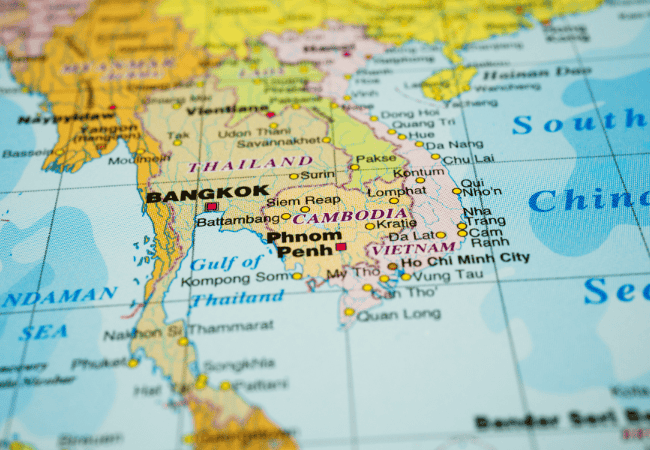
Export to Southeast Asia: opportunities and risks for Italian SMEs
Summary
Southeast Asia represents a real opportunity for Italian SMEs aiming to internationalize, but it requires a methodical and structured approach. This article analyzes the success factors for effectively entering dynamic markets such as Indonesia, Vietnam, Thailand, Malaysia, Singapore and the Philippines, highlighting winning strategies in partner selection, regulatory compliance and managing cultural complexities. Common mistakes to avoid and the importance of professional coaching to turn geographic distance into lasting competitive advantage are also outlined.
______________________________________________________________________________
When it comes to export to Southeast Asia, one does not choose a single country, but a portfolio of very different markets. Coexisting are a small but extraordinarily developed trade hub, such as Singapore, and accelerating economies such as Vietnam, Indonesia or the Philippines; mature manufacturing hubs (Thailand, Malaysia) and service-oriented systems with intensive use of digital.
For an Italian SME, this mosaic can become a competitive advantage: it allows it to diversify, grow and approach global supply chains undergoing reorganization. But it is an opportunity that must be planned methodically, because the same heterogeneity that generates opportunities also introduces regulatory, cultural and operational complexities.
Export to Southeast Asia: why look to the region now
Three dynamics make the Southeast Asia particularly interesting. The first is. the expansion of demand in large metropolitan areas: more affluent households, rapid urbanization, “aspirational” consumption in durable goods, housing, quality food, health and leisure. The second is the movement China+1: Some of the global manufacturing capacity is being redistributed along the Vietnam-Thailand-Malaysia-Indonesia axis. In practice, those who manufacture or supply machinery, components, automation and technical services are faced with new supply chains to serve. The third factor is the widespread digitization: ecommerce, electronic payments, last-mile logistics and social commerce are now commonplace, with positive effects on both B2B lead generation and the B2C buying experience.
In parallel, the presence of world-class logistics hubs, such as competitive ports and airports, and reliable transit services, facilitates lead times and parts management. For those selling capital goods or high-value products, this means being able to promise (and keep) SLA credible for service.
Where an Italian SME can create value
The area is receptive to the Made in Italy when the proposition moves beyond price to performance, safety, efficiency, and design. For exports to Southeast Asia, in capital goods (CNC, automation, packaging machinery, measuring systems) opportunities emerge in Vietnam, Thailand, and Malaysia, where electronics, automotive, and mechanics require consistent quality and integration capabilities. In Indonesia, in addition to the food industry and construction, demand touches water, energy and waste management: pumps, valves, treatment and power quality solutions are sensitive topics.
In Food & Beverage, growth is not only in the final consumption of Italian products; there is also room for ingredients, processing machinery, sustainable packaging and traceability systems. Contract furniture finds a full-bodied pipeline in the hotel, retail and commercial spaces, where reliable delivery and post-installation support make the difference. In healthcare and medical, niches are opening up in diagnostic equipment and low/medium complexity devices, while the green economy pushes projects on renewables, building efficiency, and water treatment: turnkey offerings that combine product, engineering, and service win here.
EU-ASEAN bilateral agreements: an evolving pathway
L’free trade agreement signed between the European Union and Indonesia in September 2025 marks a turning point in trade relations between Brussels and Southeast Asia. After nine years of negotiations, the understanding calls for the elimination of duties on more than 90% of products, including the phasing out (within 5 years) of the fares to 50% on European cars. This achievement represents the Third success of the EU's bilateral approach. in the region, following agreements with Singapore (2019) and Vietnam (2020). The bilateral strategy, adopted after intra-regional negotiations stalled in 2009, is proving effective in overcoming regulatory heterogeneity among ASEAN countries. Now Brussels aims to close negotiations with Thailand, Malaysia and the Philippines by 2026. For Thailand, the region's automotive hub, the Indonesian agreement sets an important precedent for the gradual dismantling of tariffs in the sector. Malaysia, the world's second largest producer of palm oil, could benefit from the removal of European duties on the product, while the Philippines could access more favorable terms for digital and fintech services. In the medium term, these bilateral agreements could set the stage for a broader regional arrangement, gradually transforming the current fragmentation into a framework of Consistent trade cooperation between the EU and ASEAN.
Understand the differences between countries (without falling into generalizations)
The specifics of individual Southeast Asian markets.
Each country in the area has distinctive characteristics that require different approaches. Understanding these differences, without falling into oversimplification, is critical to building an effective and sustainable entry strategy over time.
- Singapore - The regional hub par excellence
Singapore is often configured as the Ideal base of operations to coordinate activities throughout the region. The country offers an extremely clear and transparent regulatory environment, fast and efficient administrative procedures, and high quality standards in all areas. However, it must be considered that cost levels-both for space and personnel-are significantly higher than in the rest of the region, and that competition is particularly qualified and fierce. In this context, the added value of the proposal must be immediately evident and quantifiable.
- Malaysia - The Balanced Gateway
Malaysia presents itself as a particularly business-friendly environment, with a well-developed ecosystem of industrial clusters in the electronics and advanced components sector. The country boasts good logistics infrastructure and a particular sensitivity to halal certification in some strategic industries, an element that can open up opportunities to third-party markets as well. It represents a balanced “gateway” to the region, offering manageable operating costs combined with widespread and established technical expertise in the local industrial fabric.
- Thailand - The automotive heartland of Southeast Asia
Thailand has developed over the years, Particularly well-established and integrated automotive and component supply chains. What matters most in this market is consistent product quality, reliability in delivery time, and excellence in after-sales service. A crucial aspect to consider is that local communication tends to be more indirect and oriented toward the preservation of harmony in relationships: the business relationship must therefore be cultivated with continuity, patience and deep respect for local forms and protocol.
- Vietnam - The epicenter of offshoring from China
Vietnam has established itself as the epicenter of the “China+1” strategy” for consumer electronics, mobile devices and manufacturing assembly. The country is characterized by very high operating rates and a marked openness to the adoption of advanced manufacturing technologies. However, it is essential to maintain strict discipline in certification, technical documentation and delivery planning.
- Indonesia - A continent more than a country
Indonesia represents a continental-sized marketi, with very marked regional differences across geographic areas. Demand is particularly vibrant in the Food & Beverage, Energy & Utilities, Construction & Infrastructure, and Modern Retail sectors. Digital payments and cash on delivery (COD) are extremely prevalent at all levels. In this context, having a local partner with real, widespread territorial coverage makes as much of a difference as intrinsic product quality. In-house logistics requires special design attention and cannot be improvised, given the archipelagic nature of the country.
- Philippines - The hub of private health care and services
The Philippines uniquely combines a highly developed private health care system, growing infrastructure projects, and a strong presence of business process outsourcing (BPO) services. The country's archipelagic geography dictates targeted logistics choices and careful distribution planning. In this market, trust in service and support weighs significantly more than just a discount on the list price.
The risks to be governed (and how they are reduced in practice)
- The first hurdle for exporting to Southeast Asia is the compliance. Standards and records vary by country and product (electrical safety, pressure, food, medical). Arriving without mapping for HS queues and without documentary evidence means exposing yourself to customs blockages and reputational damage. There is a need to plan for testing, manuals and labels in local languages, reliable notified bodies and, where appropriate, pre-shipment checks.
- A second theme concerns foreign ownership and local requirements. In some areas, there are quota limits or local content requirements to compete. This is not a reason to give up, but to choose the appropriate entry model: distributor and service partner to start, light JV or final assembly when critical mass warrants it.
- La logistics needs to be thought about upstream: congested ports, seasonal weather and holidays can undermine ambitious promises. A local stock of spare parts and consumables, guaranteed response times, consistent incoterms, and alternative transportation channels (sea/air/land) reduce risk.
- Finally, it is important to consider cultural aspects and negotiation patterns. In many Southeast Asian countries, the communication is based on personal relationships and context: you rarely get a direct “no.” Therefore, it is useful to organize periodic meetings, send written reports with actions to be taken and their deadlines, and build teams that combine Italian and local expertise. One must also respect religious and cultural calendars, such as Ramadan, Tet, Songkran, and Chinese New Year.
On the B2B payment front, special care should be taken: in markets where payment times are long or where different methods coexist (e-wallets, payment on delivery), it is advisable to require an advance for customizations, use letters of credit or SBLC for larger orders, and, when appropriate, take out credit insurance.
The first 90 days matter more than you think
The entry process should be structured in methodical and progressive way. The initial phase involves the development of a scorecard integrating key parameters such as segment size, growth rate, non-tariff barriers, certification requirements, logistical complexity, country risk profile and operational ease. Based on this analysis, two pilot markets are identified on which to focus initial activities.
Subsequently, it is can proceed with structured interviews targeting distributors, system integrators and end-users, aimed at assessing actual territorial coverage, after-sales service quality and value alignment. Once the most suitable partners have been identified, a detailed term sheet is formalized that clearly specifies: territorial perimeter, distribution channels, minimum sales targets, Service Level Agreement (SLA) and regulations related to trademarks and intellectual property.
At this point a commercial pilot with a selected number of qualified customers, which includes demonstration activities, preparation of quotations, monitoring of response times and systematic collection of technical feedback. Only after this pilot phase is completed are price lists, Incoterms terms, warranty and service packages, localized technical documentation, and joint scheduling of participation in trade shows, industry events, and sales visits.
The most common mistakes (and how to avoid them)
The most common mistakes in Southeast Asia often stem from an underestimation of operational complexity. Many companies enter the market without having completed proper certification mapping, underestimating local regulatory requirements. Others promise unrealistic delivery schedules, without considering the actual logistical challenges of the area. Partner selection is equally critical: selecting a distributor based only on reputation, without checking its actual operational coverage and service capability, can undermine the entire business strategy.
Another frequent mistake is to apply a uniform approach to countries that differ profoundly in culture, regulation, and market dynamics. Finally, neglecting intellectual property protection or leaving contractual ambiguities about licensing and design can generate significant problems in the medium term.
Preventing these risks requires a structured approach: detailed and clear contracts, regular audits of partners, joint training programs and systematic communication that clearly distinguishes between established facts, working assumptions and personal opinions.
Why be accompanied
Exports to Southeast Asia today represent a’strategic opportunity for Italian SMEs who aspire to grow beyond domestic borders. This dynamic and rapidly expanding market rewards companies that can combine vision and operational rigor: identifying the most promising segments, differentiating themselves through quality, service and regulatory compliance, and building strong partnerships with reliable local players.
Success requires a structured approach: careful analysis of target markets, rigorous selection of distribution partners, adjustment of products to local regulations and effective management of the supply chain. With the right method, geographic distance is transformed from an obstacle into a lasting competitive advantage.
To successfully address these challenges and translate Southeast Asia's opportunities into concrete results, Octagona provides 20 years of experience in accompanying Italian companies on their internationalization journey. With in-depth knowledge of Asian markets, we support SMEs in defining winning strategies, selecting the most suitable partners, and operationally managing expansion.
Contact us to find out how we can support your company on this international growth path.




